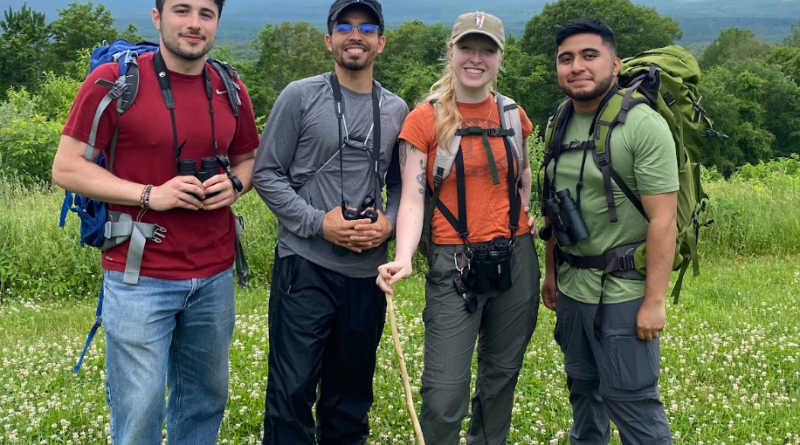New Paltz Biology researchers climb Catskill High Peaks to study off-trail hiking’s impact on imperiled songbirds

The popularity of hiking in the Catskill Mountains has skyrocketed since the pandemic, and app-driven navigation allows hikers to blaze their own trails. However, the Catskills’ highest peaks are also home to vulnerable songbird populations impacted by climate change.
Kara Belinsky, associate professor of Biology at SUNY New Paltz, and a team of student and alumni researchers are studying this issue in the field this summer, backpacking into the high peaks to count the numbers and types of birds singing on the mountaintops at dawn and measure how off-trail hiking is affecting the birds.
This project began in summer 2023 with funding from the Catskill Science Collaborative, coordinated by the Cary Institute of Ecosystem Studies in Millbrook, New York. The researchers surveyed birds at 72 locations on 10 different mountaintops, finding that hiking trails significantly reduced bird numbers and bird diversity. The number and diversity of birds was lowest on official trails, intermediate on unofficial trails with high hiker use, and highest at the control sites: pristine forest sites with little to no signs of hiker use.
The project is a collaboration with land managers at the New York State Department of Conservation (DEC) who will use the data to manage the trails, and scientists at The Vermont Center for Ecostudies (VCE) in White River Junction, Vermont, who are studying montane birds across the Northeast.
The team is back in the mountains this summer continuing this important research with additional funding from the Catskill Science Collaborative, new funding from the 3500 Club, and a SUNY New Paltz Research & Creative Project Award.
Supporting Belinsky this year are lead researchers Danielle Takacs ’23 (Biology) and Samuel Mateo, Jr. ’21 (Biology), and new collaborators Andres Barragan ’23 (Biology) and Chris Gabelman ’25 (Biology).
For these young scientists, the experience has provided exciting adventures in the mountains while empowering them to make critical contributions to bird biodiversity conservation in the Hudson Valley.
“My favorite memory of the trip was waking up at 4 a.m.,” Barragan said. “The forest was silent, the air felt cool and mystical, and within 20 minutes, the dawn chorus began. I had only ever heard recordings of our montane birds, so hearing a Winter Wren, Swainson’s Thrush, and a Bicknell’s thrush all at once was pretty remarkable!”
“The thing that surprised me the most was how magical everything felt once you hiked up to a certain altitude,” said Gabelman. “It was an awesome experience and I’m looking forward to the next trip.”
To learn more about this project, follow the team on Instagram @newpaltzornithology.


